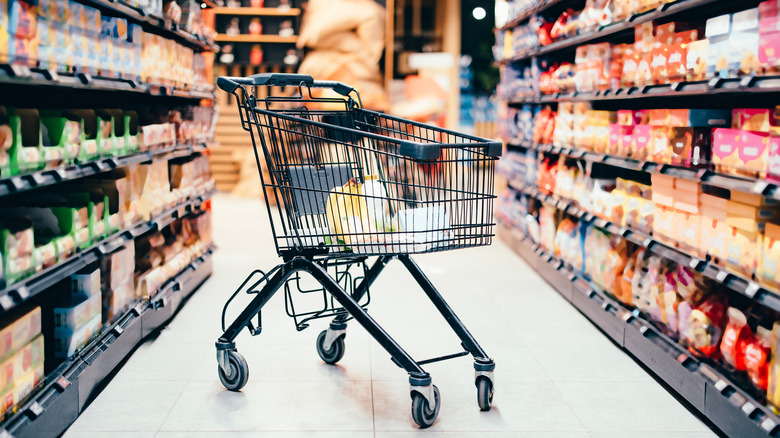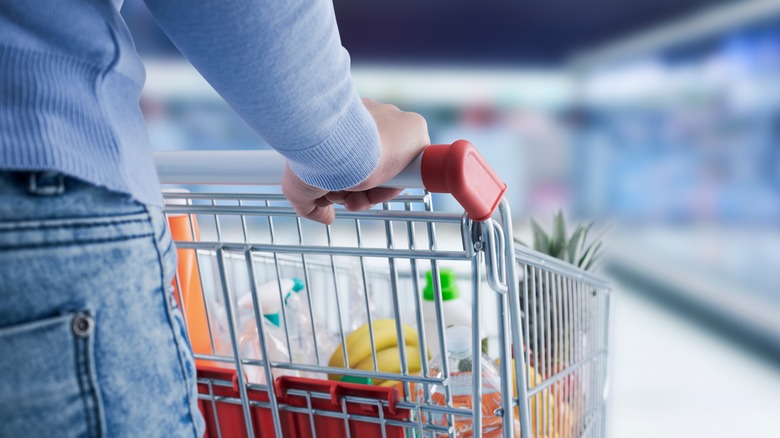Why Not Grabbing A Shopping Cart Is Bad Grocery Etiquette
Of course, most of us understand that there's such a thing as grocery store or supermarket etiquette. Every food-related event has a code of conduct associated with it, defining what does or does not constitute good manners. This is true for fine dining in fancy restaurants, but also for less obvious environs. Drive-thru lanes have etiquette rules too, and yes, so does grocery shopping.
In the case of grocery shopping, one rarely needs an etiquette guide to know what's right and wrong. Just about everyone understands, for instance, that eating food you haven't paid for yet is rude. Getting in an express lane with far more than 10 items in your cart is a no-no. So, too, is failing to put food items back in their proper aisles after deciding you don't want them anymore, which people are especially prone to do when they don't grab a shopping cart. Believe it or not, there are other offenses associated with leaving a shopping cart in the corral, even though it can feel like the right thing to do if you only have a few items.
The ins and outs of shopping cart etiquette
There's an entire subcategory of grocery store etiquette devoted solely to the shopping cart. The four-wheel food transport has proved invaluable since it was first introduced back in the 1930s. There are rules about where to leave them in parking lots, where to park them for the convenience of other shoppers (hint: never in the middle of the aisle), and about the condition in which one should leave them in after checkout (without trash inside, of course).
The necessity of using a shopping cart or, alternatively, a basket — even for minor shopping forays — is a lesser-known dictum. However, the reasoning behind the unspoken rule is solid. For one thing, it's just safer. You're much less likely to drop something on the floor — thus requiring others to clean up after you — when using a cart. Carrying a few items in one's hands is a recipe for disaster. It's just a completely unnecessary risk, especially since there's no charge for using carts or baskets.
But grocery carts help with more than just safety issues. The number one no-no when it comes to grocery etiquette is infringing on the personal space of other shoppers. Many of the etiquette rules associated with food shopping, in fact, are directly related to this issue. The cart, despite its size, actually helps to prevent such infringements.
Advanced shopping cart etiquette
It's an underrated aspect of shopping cart use, but this handy food transport provides a built-in buffer against encroaching into the personal space of others — and vice versa. For example, you can maneuver it to provide breathing room while shopping for items in a busy aisle, or to ensure ample personal space when standing in line to pay. So, for reasons related to both safety and politeness, grabbing a cart is always recommended.
For those who aspire to expert-level grocery etiquette, there are a few more rules to remember. Don't just commit to getting a cart; choose the best model available. No, you needn't pick through a line of carts to evaluate the merits of each one individually, but you should make sure your cart of choice doesn't have a sticky wheel — or worse, one that squeaks. Picking a lemon of a cart not only makes your own shopping experience decidedly less enjoyable, but its annoying squeaking or lack of proper maneuverability could negatively impact the experience of other shoppers as well.
When you're finished shopping, don't just abandon your cart in the middle of a crowded parking lot. This haphazard disposal method has many drawbacks, including making it harder for incoming shoppers to access parking spaces. Deposit the cart in an appropriate cart corral; your fellow shoppers will appreciate it.



